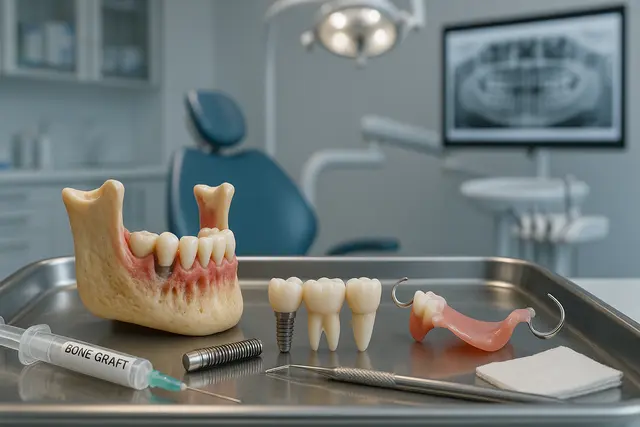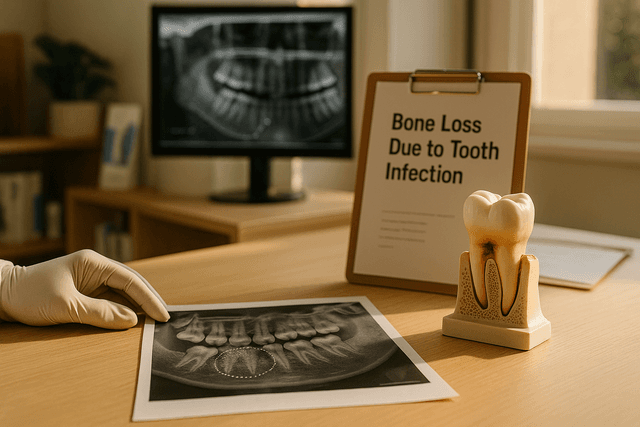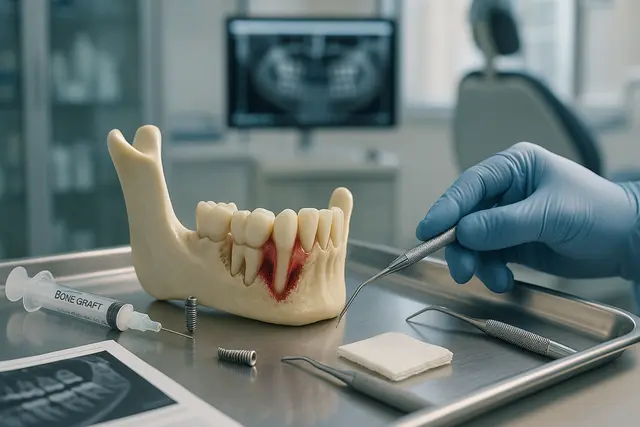Oral Health
7 min read
Jul 03, 2025
How to Fix a Broken Tooth Temporarily Before Seeing a Dentist
Crack. You felt it, didn’t you? One second you’re enjoying your snack, the next you’re dealing with a chipped or broken tooth, and now you’re wondering what to do before you can see a dentist. Whether it’s a sharp edge cutting your tongue or a sudden jolt of tooth sensitivity, don’t panic.

So, you bit into a popcorn kernel or chewed on a piece of ice like it owed you money, and now you’ve got a broken tooth. Ouch. Whether it’s a small chip or a noticeable break, it’s the kind of surprise no one wants. The good news? You can fix a broken tooth temporarily before seeing a dentist, and no, it doesn’t involve super glue. Let’s walk through what you need to know to protect your smile and keep the pain at bay until professional help steps in.
First Things First: What to Do When You Chip Your Tooth
You’d be surprised how common it is to chip your tooth. Chipped teeth happen to everyone from toddlers to NHL players to those of us who just forgot about that olive pit. If you chipped a tooth or broke part of one, the first step is not to panic. Check your mouth. Is it bleeding? Does the tooth feel loose? Is the jag sticking out like a tiny knife?
If there’s blood, rinse your mouth with warm water to clear it up and stop any debris from getting stuck in places it shouldn’t. A chipped tooth may not always hurt, but don’t be fooled; that doesn’t mean you’re in the clear. Tooth damage might expose the inside of the tooth (the pulp), and leaving that untreated is like leaving your door wide open during a snowstorm. Not ideal.
If you still have the part that chipped off, wrap it in a clean, damp cloth or place it in milk. Yes, milk. Dentists sometimes use that piece for restoration, depending on the extent of the damage.
When You Need to Fix a Broken Tooth at Home
Look, we all know there’s no true substitute for professional dental care. But that doesn’t mean you’re helpless if your dentist’s office is closed or you can’t get an appointment right away. Fixing a broken tooth at home isn’t about making it perfect; it’s about getting a temporary fix that protects the affected tooth and keeps you comfortable.
Here are a few quick things to do:
Clean the area: Rinse your mouth with warm water. If you’ve got salt, mix some in to help prevent infection.
Apply pressure if needed: If there’s bleeding, use clean gauze or a paper towel.
Use dental wax: Got a jagged edge scraping your cheek or tongue? Dental wax is your friend. Roll a small piece between your fingers, press it onto the jag, and smooth it out.
Pain relief: Over-the-counter pain relievers can help, but follow the recommended dosage instructions carefully. If the pulp is exposed, you might have sensitive teeth, and a little ice or a cold compress on your cheek (not directly on the tooth!) can ease the sting.
No chewing on that side: Seriously. No chips. No jerky. No jawbreakers. Your natural tooth is fragile right now.
Fix a Chipped Tooth with a Temporary Tooth Repair Kit
For those determined DIYers, a tooth repair kit from the drugstore can be a lifesaver. These kits often contain temporary filling material that acts as a barrier between your damaged tooth and all the things in your mouth trying to make it worse, like cold drinks or food particles.
Using one is fairly simple: clean the tooth, dry it, and follow the instructions carefully. The filling material hardens quickly and provides temporary relief until you can get to the dentist.
Just remember: these kits provide temporary solutions. They are not meant to replace real dental treatment. That temporary filling material is like putting a Band-Aid on a leaky pipe; it buys you time but doesn’t fix the root problem.
See Your Dentist As Soon As You Can
Let’s be clear. If you’ve broken or chipped a tooth, you need to see your dentist. Even if it doesn’t hurt, even if you think you’ve done a decent patch job. Ignoring a broken tooth can lead to bigger issues like tooth decay, infections, or even losing the entire tooth.
A dentist may recommend dental bonding for smaller chips. This is where they use a tooth-colored resin to smooth and rebuild the missing part. If the break is bigger or the crack goes deep, a dental crown may be necessary. And if the pulp is exposed or infected? You’re probably looking at a root canal, or in worse cases, a tooth extraction.
That’s why acting quickly matters. The sooner you visit your dentist, the better your chances of keeping the remaining tooth healthy.
Chipped Tooth at Home: What’s Safe and What’s Not
Dealing with a broken tooth at home means knowing what’s safe and what can make things worse. Here’s what to avoid while you wait:
Don’t chew anything crunchy or sticky on that side.
Skip acidic foods or drinks; they can irritate the inside of the tooth.
Avoid brushing too hard around the chipped area. Just gently brush your teeth like normal, at least two times a day.
The affected tooth may already be irritated, so treat it like the VIP it is for now.
Tooth Repair Methods Your Dentist May Use
Once you get to the dental office, the dentist will assess the extent of the damage. Fixing a broken tooth depends on several factors: how deep the crack is, whether the pulp is involved, and how much of the original tooth is left.
Common tooth repair methods include:
Dental bonding for chips and surface cracks
Veneers if the front tooth is chipped or stained
Crowns to protect a damaged tooth or hold together a fractured tooth
Root canal treatment if the inside of the tooth is infected
Tooth extraction if the tooth is beyond saving
Each method has pros and cons, and your dentist may suggest the one that offers the best long-term results. Sometimes a chipped tooth may seem minor but hide deeper problems. A quick fix might hold you over, but a solid plan ensures you’re not back in the chair two months later.
What Home Remedies Can Help?
Home remedies can support temporary care, especially if you can’t get to the dentist right away. While they’re not a substitute for professional dental care, some steps you take at home can provide temporary relief:
Swishing with saltwater helps reduce bacteria and prevent infection
Clove oil can help with tooth sensitivity or minor pain
Applying dental wax over the jagged edge keeps it from cutting your gums or tongue
Using a cold compress on the outside of your cheek can reduce swelling
These can be especially helpful when dealing with toothache from cracked or broken teeth
Tooth Damage and Dental Insurance: What You Need to Know
Tooth repair isn’t just about health; it can be a hit to the wallet, too. The good news? Most dental insurance policies cover broken tooth repair if it’s not caused by neglect. That means if you chip your tooth falling off a scooter or biting a tortilla chip (we’ve all been there), you might only owe a small copay or deductible.
Check your plan to see what’s covered. Preventive dental care is usually fully covered, and emergency procedures like dental bonding or crowns often have partial coverage. And keep in mind, if you have a history of tooth decay or untreated damage, your dentist may be able to spot early issues before a bigger break happens.
Different Types of Tooth Chips and Cracks
Let’s talk about the different types of tooth injuries because not all cracks are created equal:
Minor chip: Just the enamel. No pain, usually an easy fix.
Fractured tooth: Might extend into the pulp and cause pain or sensitivity.
Cracked tooth: A vertical crack that hasn’t split the tooth entirely yet.
Broken tooth: A serious chunk is missing, and the pulp might be exposed.
Tooth is missing: Yep, the whole thing popped out. That’s an emergency.
Understanding the extent of the damage helps you communicate with your dentist and decide what steps to take at home.
Fix a Chipped or Broken Tooth Without Losing Your Mind
Dealing with a broken tooth doesn’t mean you have to suffer through it like some medieval knight. Sure, you’re not a dentist, but with the right tools, some patience, and a little bit of humor, you can protect your smile until you get the care you need.
Just remember: no matter how good your temporary fix is, it’s just that temporary. You need to visit your dentist to make sure the issue doesn’t come back with a vengeance.
Take care of those pearly whites, and try not to bite down on hard candy like you’re in a jaw strength competition. Your teeth will thank you.
What Should I Do Immediately After Chipping a Tooth?
Start by rinsing your mouth with warm water and checking for bleeding or loose pieces. If there’s bleeding, apply gentle pressure with gauze. Save any broken fragments in milk and use dental wax to cover sharp edges. Avoid chewing on that side and schedule a dentist appointment as soon as possible.
Can I Temporarily Fix a Broken Tooth at Home?
Yes, but only for short-term relief. Use dental wax or a temporary tooth repair kit from the pharmacy to protect the area. Over-the-counter pain relievers and saltwater rinses can also help with discomfort. These methods are temporary and do not replace proper dental care.
What Tooth Repair Options Will a Dentist Recommend?
Your dentist will assess the severity of the damage and may suggest dental bonding, a crown, a veneer, or root canal therapy if the pulp is exposed. In severe cases, extraction may be necessary. The right solution depends on the size and location of the break.
Is a Chipped or Broken Tooth Always a Dental Emergency?
Not always, but it should never be ignored. A small chip might be minor, but deeper cracks or exposed pulp can lead to infection or tooth loss if untreated. Even if there’s no pain, seeing a dentist promptly is the best way to protect your long-term dental health.
Read Next
Related Posts

Oral Health
Tooth Replacement Options to Prevent Bone Loss
Losing a tooth isn’t just about appearance, it can have a lasting impact on your oral health, jawbone strength, and overall quality of life. When teeth go missing, the jawbone begins to shrink, which can change your bite, your facial structure, and even your confidence. Fortunately, modern dentistry offers several effective solutions to replace missing teeth and prevent further bone loss.
4 min read
Sep 26, 2025

Oral Health
Bone Loss Due to Tooth Infection Explained: What It Means for Your Oral Health
A tooth infection isn’t just about pain, it can quietly damage the tissues around a tooth and even erode the jawbone that supports your smile. This guide explains how infections start, why they can lead to bone loss, the warning signs to watch for, and the treatments that can stop the spread and rebuild lost support.
5 min read
Sep 25, 2025

Oral Health
Understanding Bone Loss in Teeth: Causes and Treatments That Work
Bone loss in teeth is a silent threat that can compromise your smile, facial structure, and overall oral health. While it often goes unnoticed in the early stages, it can lead to serious consequences if left untreated. Understanding what causes dental bone loss, and how to prevent or manage it, is key to maintaining a strong, healthy foundation for your teeth.
5 min read
Sep 25, 2025
Don’t have time to research every dentist around you?
See why 30k+ patients trusted us